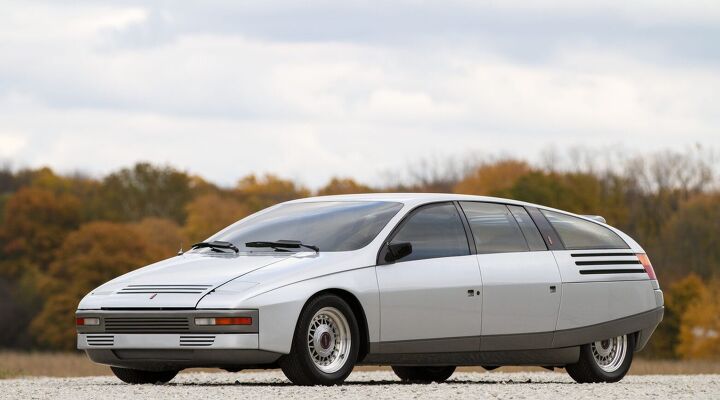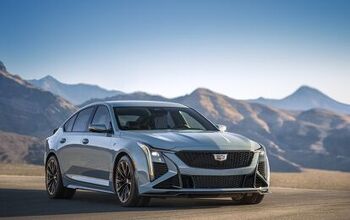Rare Rides: A Year Later, Ghia's 1983 Lincoln Quicksilver

Today’s post serves as a couple of milestones at TTAC (for me, anyway); 200 articles written, and a year of Rare Rides. Since I did not plan this in any way or think about it in advance, I thought we might make this post a bit special. Bringing us back to the very first Rare Rides entry of one year ago, we have another concept car Ghia designed for Ford which never saw the production green light.
Presenting the 1983 Lincoln Quicksilver.
While the Probe concept from 1979 was all about the angular wedge, the Quicksilver offers a much smoother teardrop design to carry out its sedan mission. More on that in a moment.
Though several designs produced by Ghia wore a Probe name, the Quicksilver was a one-off for the Lincoln brand. For years, Ford was keen on investigating what aerodynamics could do for design, which they’d prove three years after the Quicksilver with the production Taurus and light bar Sable (mmm).
You might think underneath the sweeping lines of the body lies some European Ford chassis, perhaps a Capri or Transit. Nope, there’s an AC under there, specifically the 3000ME. On sale between 1979 and 1984 (a total of 101 cars), the 3000ME was mid-engined, two-seat, rear drive vehicle, equipped with a 3.0-liter V6 Ford engine.
Ghia extended the 3000ME chassis by 11 inches to accommodate the larger body, keeping the mid-engine layout and the manual transmission. Quite the odd arrangement for any Lincoln; think of the Quicksilver in 1985’s showrooms, next to a Town Car and a Continental Valentino. I mentioned before it’s a sedan — the rearmost side windows, louvres, and spoiler are for show. They’re merely decorations over the horizontal engine cover.
Around the front we find the only design feature implemented in production Ford models. Does it look familiar? With minimal changes, what you have here is the front end of the Probe for 1989.
It’s worthwhile to mention the deep-dish alloys, which are really working for me. I’d put them right on a Mark VII (LSC, of course).
The interior accommodations are starkly different from standard Lincolns of the time. Rounded surfaces and radial gauges remind the driver and passengers this is the Lincoln of a new age.
Despite the generous exterior proportions, rear leg room is not quite what one might expect. It’s another downfall of mid-engine placement, which eats up the rear third of the Quicksilver.
In the end however, the craziness of the Quicksilver was not realized. Stored for decades with the other Probe series design studies, it was sold around 2003 for the paltry sum of $8,000. Mecum sold it again in 2014 for $27,000, with proceeds going to charity.
Maybe after a second year of Rare Rides, we’ll find another Ford Ghia to showcase. I’m always telling Sajeev how the internet can only handle so much Ghia style at once.
[Images via Mecum]

Interested in lots of cars and their various historical contexts. Started writing articles for TTAC in late 2016, when my first posts were QOTDs. From there I started a few new series like Rare Rides, Buy/Drive/Burn, Abandoned History, and most recently Rare Rides Icons. Operating from a home base in Cincinnati, Ohio, a relative auto journalist dead zone. Many of my articles are prompted by something I'll see on social media that sparks my interest and causes me to research. Finding articles and information from the early days of the internet and beyond that covers the little details lost to time: trim packages, color and wheel choices, interior fabrics. Beyond those, I'm fascinated by automotive industry experiments, both failures and successes. Lately I've taken an interest in AI, and generating "what if" type images for car models long dead. Reincarnating a modern Toyota Paseo, Lincoln Mark IX, or Isuzu Trooper through a text prompt is fun. Fun to post them on Twitter too, and watch people overreact. To that end, the social media I use most is Twitter, @CoreyLewis86. I also contribute pieces for Forbes Wheels and Forbes Home.
More by Corey Lewis
Latest Car Reviews
Read moreLatest Product Reviews
Read moreRecent Comments
- Lou_BC Well, I'd be impressed if this was in a ZR2. LOL
- Lou_BC This is my shocked face 😲 Hope formatting doesn't fook this up LOL
- Lou_BC Junior? Would that be a Beta Romeo?
- Lou_BC Gotta fix that formatting problem. What a pile of bullsh!t. Are longer posts costing TTAC money? FOOK
- Lou_BC 1.Honda: 6,334,825 vehicles potentially affected2.Ford: 6,152,6143.Kia America: 3,110,4474.Chrysler: 2,732,3985.General Motors: 2,021,0336.Nissan North America: 1,804,4437.Mercedes-Benz USA: 478,1738.Volkswagen Group of America: 453,7639.BMW of North America: 340,24910.Daimler Trucks North America: 261,959









































Comments
Join the conversation
I'm really liking the clean DLO on this car.
Can't say I'm disappointed this didn't make it to production. Never been a fan of the wedge look, at least not this radical (nor on some famous 1980s super cars, just not my style). The idea of a mid-engine, manually shifted Lincoln is fascinating, but it shouldn't be a sedan since the rear seat is useless. Maybe a ultra-PLC (what could be more personal than a two seater?) with a dash of sport, with about 50% less wedge, a high-output 302 or 351 V-8 (it was 1983 after all) and fixed headlamps (yes, I know being 1983, they'd be sealed beam, but maybe by production, say 1986ish, they could've used modern flush headlamps). I do like the wheels.